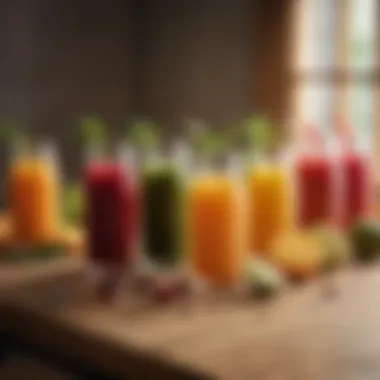Explore the Top Manual Fruit Juicers Today


Intro
In an age where convenience often reigns supreme, the quest for quality and control in our food preparation has led many back to the basics. Manual fruit juicers, with their simplicity and effectiveness, have gained attention among discerning consumers. This article delves into the world of manual juicers, offering an insightful perspective on their advantages and identifying top models available in the market. Whether you are a novice looking to experiment with juicing or a culinary enthusiast in search of the best tools, understanding manual juicers can elevate your juicing experience.
Manual juicers tend to stand out for their energy efficiency and skillful design, providing a hands-on approach to extracting fruit essence. Unlike their electric counterparts, which can sometimes compromise texture and flavor, manual juicers allow for precise control over the juicing process. Furthermore, they generally require less maintenance and have longer lifespans, appealing to eco-conscious consumers.
In this comprehensive guide, we will highlight important considerations when selecting a manual juicer. We will also explore top models, share benefits exclusive to manual juicing, and provide essential maintenance tips. Such knowledge equips readers to make informed decisions while enhancing their culinary adventures.
Understanding Manual Fruit Juicers
Manual fruit juicers serve a unique purpose in today’s kitchen. They cater to consumers seeking a simple, effective way to extract juice from fruits without the need for electricity. In an age of technological advancement, the manual juicer stands as a testament to the effectiveness of traditional methods.
Using manual juicers can help maintain the qualities of fresh juice. This is critical for those who value the nutritional benefits of drinking raw fruit juices. Moreover, these juicers offer a cost-effective solution against the backdrop of electric models. They provide a more straightforward approach to juicing, making them an attractive option for many.
Defining Manual Juicers
Manual juicers can be defined as tools designed to extract juice from fresh fruits through physical force rather than electrical power. They typically come in various designs, ranging from handheld reamers to more complex lever-operated models. Each type serves its own purpose, suited for different fruits and juicing preferences.
Overall, they represent a blend of functionality and simplicity. This combination makes them approachable for both novice juicers and seasoned culinary experts. Understanding the different types of manual juicers helps consumers choose a model that suits their needs, whether for occasional use or daily juicing.
How Manual Juicers Work
The operation of manual juicers is quite straightforward. Users place the fruit within the juicer's compartment and apply force. This force presses or twists the fruit, allowing the juice to flow out, while pulp and seeds are separated. Some models use a more sophisticated mechanism involving levers and gears for greater efficiency.
The simplicity in design allows for easy handling and a quick cleanup process. Most parts of manual juicers are easily detachable, making it simple to wash after use. This becomes essential in maintaining hygiene and ensuring the longevity of the product.
Additionally, because they do not require electricity, manual juicers can be used anywhere, from outdoor picnics to kitchen countertops. This versatility separates them from electric counterparts, adding to their appeal.
The Advantages of Manual Juicers
Manual juicers present various benefits that cater to health-conscious individuals and those keen on a more engaging juicing experience. This section explores the primary advantages, helping readers appreciate why these devices might be the preferred choice over their electric counterparts.
Nutritional Integrity
Manual juicers help preserve nutritional integrity remarkably well. The absence of heat generated during juicing minimizes the risk of nutrient degradation compared to electric juicers. Heat can destroy crucial vitamins, enzymes, and antioxidants present in fresh fruits.
Moreover, manual juicers typically use a slower, more controlled extraction process. This enhances juice quality, ensuring that vital nutrients remain intact. The end result is a fresher drink that provides maximum health benefits.
"Choosing a manual juicer could mean starting your day with a glass full of essential vitamins and antioxidants, intact and ready to nourish your body."
Cost-Effectiveness
When considering cost-effectiveness, manual juicers shine brightly. They are often less expensive than electric models, making them accessible for budget-conscious consumers. This cost advantage extends beyond the purchase price.
Manual juicers usually consume no electricity. Hence, their long-term operational costs are virtually non-existent. This makes them an environmentally friendly option, promoting sustainable practices in the kitchen.
Aside from financial savings, they indeed require fewer repairs and replacements, boosting their appeal. The design of most manual juicers focuses on durability, often constructed from high-quality materials. This leads to a lower lifetime cost when compared with electric juicers that may experience motor failures or require battery replacements.
Portability and Storage
Portability is another crucial factor when evaluating juicers. Manual juicers are typically lighter and more compact than their electric counterparts. This convenience means they can be easily transported, whether for a picnic or travel.


Storage is equally practical. Since they take up less space, they can conveniently fit into kitchen cabinets or drawers, avoiding the need for extensive counter space. For people in small apartments or kitchens where space is a premium, such features are particularly advantageous.
Top Manual Fruit Juicers on the Market
The segment on manual fruit juicers in the market is crucial for discerning consumers. As more individuals seek healthier lifestyles, the interest in manual juicers has increased. These devices offer simplicity, portability, and cost-effectiveness compared to their electric counterparts. By examining the features and performance of manual juicers, readers will better understand their choices. Additionally, exploring notable models will provide actionable insights into the available options. This section will help transform your juicing experience by highlighting valuable products that meet quality and functionality standards.
Evaluating Features and Performance
When selecting a manual juicer, it is important to evaluate specific features that influence performance. The construction material plays a key role. Stainless steel and sturdy plastics often offer durability and ease of cleaning.
The design is another significant factor. Juicers with ergonomic handles or optimized leverage can reduce physical strain during usage. The size of the strainer and juicing area affects juice yield and quality as well. Moreover, consider the juicer's compatibility with various types of fruits. A versatile manual juicer can handle citrus, soft, and hard fruits efficiently, enhancing its usability in your kitchen.
Highlighting Notable Models
Model A: Specifications and Benefits
Model A, the Handy Juicer X1, stands out for its solid construction and user-friendly design. With a heavy-duty stainless steel frame, this juicer ensures long-lasting performance. Its ergonomic grip allows for comfortable juicing, minimizing hand fatigue. The X1 offers a unique feature: a built-in mesh filter that effectively separates juice from pulp, making it a popular choice among users seeking low-maintenance options for juicing.
Model B: Specifications and Benefits
Another noteworthy model is the Citrus Champion Manual Juicer. This juicer focuses on citrus fruits, proving highly efficient for oranges, lemons, and limes. Its key characteristic includes a quick-press action, which maximizes juice extraction with minimal effort. The advantage of this model is its compact size, perfect for small kitchens or on-the-go lifestyles. However, it may not perform as well with hard fruits.
Model C: Specifications and Benefits
Lastly, the VersaJuicer 2000 caters to those who prioritize versatility. This model accommodates a wide range of fruits, from tomatoes to apples. It is built from BPA-free plastic, ensuring safety while juicing. The standout feature of the VersaJuicer 2000 is its adjustable juicing pressure, allowing you to customize the extraction based on the fruit's hardness. This model offers a great balance of performance and ease of use, but its plastic build may not appeal to those who prefer metal.
"Choosing the right manual juicer involves understanding mechanical design, materials, and personal preferences, leading to better juicing choices."
In summary, the manual fruit juicer market offers various models with distinctive strengths. Evaluating features such as material quality, ease of use, and versatility is essential for making informed purchasing decisions.
Factors to Consider Before Purchase
When selecting a manual fruit juicer, a few key factors can greatly influence your experience and satisfaction. Each aspect of the juicer can either enhance or detract from the juicing process. This section aims to break down essential points that you should keep in mind before making a purchase.
Material Quality
Material quality plays a fundamental role in the durability and overall effectiveness of a manual juicer. Most juicers are made from stainless steel, plastic, or glass. Stainless steel is often preferred because it is robust and resistant to corrosion. Plastic juicers can be light and affordable but may not offer the same longevity as metal counterparts. Glass components are not only aesthetically pleasing but also do not absorb odors or flavors from the juice.
Choosing a juicer made from well-regarded materials will ensure it withstands the rigors of regular use. A good-quality juicer can last for years if maintained properly. Look for products that mention BPA-free materials, as this can be crucial for health-conscious consumers.
Ease of Use
Ease of use should be a primary consideration. The best manual juicers are designed to simplify the juicing process. Ergonomic designs, comfortable grips, and user-friendly mechanics will save time and effort during operation. Some juicers provide clear instructions or simple assembly features, which can be a significant benefit for novice juicers.
Additionally, consider the size and weight of the juicer. A lightweight but stable juicer will be easy to handle and transport. If possible, try juicers in-store before purchasing to assess their comfort and handling. Ease of use directly influences how often a juicer will be used so select carefully.
Cleaning and Maintenance
Cleaning and maintenance requirements are equally important factors to consider. A juicer that is difficult to clean may discourage regular use. Components should be easy to disassemble and washable, ideally safe for a dishwasher. Some brands offer less complicated parts that break down for transparency and ease of cleaning.
Regular maintenance can prolong the life of your juicer. After each use, it is essential to wash all parts thoroughly to prevent residue build-up.
A well-maintained juicer not only performs better but also promotes better hygiene, which is crucial for health-conscious individuals.
In summary, understanding these factors before purchase can lead to a more satisfying juicing experience, ensuring that the juicer meets both your functional and lifestyle needs.
Juicing Techniques for Optimal Results


Juicing is not merely about the device used; it also heavily relies on the techniques applied. The right methods can maximize juice yield and flavor while preserving the nutrients inherent in the fruits. Understanding effective juicing techniques is vital for anyone aiming to enjoy the full benefits of natural juice. Specific elements to consider include proper preparation of the fruit, correct juicing methods for various fruit types, and maintaining optimal device performance throughout the juicing process.
Preparing Fruits for Juicing
Preparation plays a crucial role in achieving optimal results when juicing. First, wash all fruits thoroughly to remove any pesticides or dirt. Cutting fruits into smaller pieces enhances the manual juicer's efficiency, making it easier to extract juice. Additionally, removing seeds can help prevent any bitterness from affecting the taste of the juice. This step also reduces strain on the juicer, potentially enhancing the longevity of the equipment.
Juicing Different Types of Fruits
Juicing methods vary significantly by the fruit type. Understanding these differences is essential for achieving the best juice.
Citrus Fruits
Citrus fruits, like oranges and grapefruits, are well known for their high juice content. Their unique structure makes them highly beneficial for juicing. The juicing process for citrus involves minimal effort since the fruits contain a significant amount of liquid. Furthermore, citrus juice is rich in vitamin C, making it a popular choice for health-conscious individuals. Their juicy segments break down easily, allowing for efficient extraction. However, one should note that citrus juices can be quite acidic, which might not be suitable for every palate or digestion.
Soft Fruits
Soft fruits, such as strawberries and raspberries, also provide excellent juice with rich flavors. These fruits have a high sugar content and a low fibrous structure, allowing them to yield a good amount of juice with ease. Prepared properly, soft fruits can deliver vibrant juices that are both nutritious and refreshing. The main disadvantage is their shorter shelf life; these fruits can spoil quickly if not used promptly. Their juicing may require more care as they can clog the strainer if not processed correctly.
Hard Fruits
Hard fruits like apples and pears require more effort to juice but offer a crisp flavor and refreshing quality. Their tougher texture means that they can provide a more substantial volume of juice when processed correctly. Hard fruits are often a staple in many juice recipes because of their balance of sweetness and tartness, and they add body to overall juice blends. However, they do necessitate more cutting and preparation, making the juicing process slightly more labor-intensive. The fibrous nature may also result in more pulp, which some users might prefer to filter out.
In summary, employing the correct techniques for preparing and juicing various types of fruits not only enhances the quality of juice but also contributes to a better overall juicing experience.
Understanding these juicing techniques enables users to make the most of their manual juicers, ensuring they get the best flavors and nutrients from the fruits they use.
Maintaining Your Manual Juicer
Proper maintenance of your manual juicer plays a crucial role in ensuring its performance and longevity. A well-maintained juicer not only enhances the juicing experience but also guarantees that your fruit juices remain fresh and nutritious. Regular upkeep can prevent common problems such as clogging and food residue buildup, which could affect the taste and quality of your juices. This section will outline essential cleaning procedures and storage recommendations, guiding you in how to maintain your juicer effectively.
Cleaning Procedures
Keeping your manual juicer clean is vital to preserve its functionality and avoid health hazards from residue buildup. After each use, it is best to rinse the juicer parts with warm water immediately. This prevents pulp and juice from drying and sticking, making later cleaning much easier.
- Disassemble the juicer: Remove all detachable parts like the funnel, pusher, and filter. Doing this step allows for thorough cleaning.
- Soak parts: If pulp is particularly stubborn, soak the parts in warm soapy water for about ten to fifteen minutes. This helps loosen any residue.
- Scrub gently: Use a soft brush or sponge to scrub the surfaces. Be careful not to use any abrasive materials that could scratch or damage the surface. Focus on crevices where pulp might hide.
- Rinse thoroughly: After cleaning, rinse all parts with warm water to remove any soap. Ensure no residue remains.
- Dry completely: Allow parts to air dry before reassembling. This step minimizes the growth of bacteria that could thrive in damp areas.
Storage Recommendations
Storing your manual juicer correctly will ensure that it remains in good working condition. Here are a few recommendations to consider when it comes to storage:
- Choose a dry place: Always store your juicer in a dry environment. Humidity can lead to mold and deterioration of materials.
- Keep it assembled or disassembled: If you have ample room, storing it assembled can save time for future use. However, if space is limited, disassemble it for compact storage.
- Use a protective cover: If possible, use a cover when storing to prevent dust accumulation. This small step could prolong the life of the juicer parts.
- Avoid extreme temperatures: Keep your juicer away from heat sources or extreme cold, which can warp or weaken materials.
Following these simple maintenance practices will significantly enhance your juicing experience, allow you to enjoy fresh, healthy juices, and ensure that your manual juicer serves you well for years to come.
"A little bit of maintenance goes a long way in preserving the quality of your kitchen appliances."
Common Issues and Solutions
In the realm of manual fruit juicers, understanding potential issues is essential. Consumers often face challenges that can hinder their juicing experience. Addressing these common concerns not only enhances user satisfaction but also extends the lifespan of the juicer. Each problem typically has practical solutions that can be implemented easily, allowing one to enjoy fresh juices without the frustration of big hassles.
Clogging and Pulp Build-Up


One frequent issue with manual juicers is clogging, particularly when juicing fibrous fruits or vegetables. As the juices are extracted, pulp can accumulate within the juicing mechanism. This can be frustrating and time-consuming when trying to produce a smooth juice. When a juicer gets clogged, it can lead to inefficient extraction and may even cause the juicer to break if excessive force is used to clear it.
To prevent clogging, it's helpful to alternate between types of fruits or vegetables while juicing. For instance, using softer fruits like berries can help push out the pulp that accumulates from tougher vegetables such as carrots or beets. Additionally, regularly cleaning the strainer and filter after each use will keep the juicer functioning effectively. Having a simple brush handy can assist in removing any stuck pulp, making the thorough maintenance routine even easier.
Difficulty in Extraction
Another issue that users often encounter is difficulty in extracting juice, mainly due to insufficient manual exertion. Many manual juicers require a certain amount of force, and not everyone is aware of the best techniques to maximize extraction. This situation can lead to disappointing yields, where a user feels they are putting in significant effort for minimal juice output.
To enhance extraction efficiency, one should ensure that the fruits are cut into smaller pieces before juicing. This can ease the strain on the juicer and lead to better yields. Moreover, using fruits at room temperature may soften them, making juicing easier. Sometimes, simply adjusting the angle of the juicer or the way pressure is applied can make a big difference. Experimentation with techniques can lead to a customized approach that works best for the user.
"Proper handling and knowledge are crucial to maximizing the benefits of a manual juicer."
Having understanding about common issues and knowing the corresponding solutions can empower users, helping them derive the best results from their manual juicer experience.
Comparing Manual and Electric Juicers
When considering fruit juicers, the choice between manual and electric options is crucial. Each type has unique attributes that influence functionality, user experience, and practicality. Understanding these differences can help consumers make informed decisions based on their individual needs, preferences, and lifestyle.
Energy Consumption
One significant advantage of manual juicers is their energy consumption. Unlike electric juicers, manual ones do not require electricity for operation. This can be particularly beneficial for those who are conscious of energy use, want to reduce their carbon footprint, or are interested in off-grid living. Manual juicers facilitate the process of juicing without contributing to energy bills or environmental concerns.
In addition, manual juicers can often juice fruits during power outages, making them reliable during emergencies. They offer an eco-friendly juicing experience. The simplicity of their design ensures that all energy used comes directly from the user's effort, thus promoting a more hands-on and engaging approach to health and wellness.
Juicer Longevity
When discussing longevity, manual juicers often outlast electric models. Manual juicers generally have fewer components that can break down or malfunction over time. They are typically made from durable materials such as stainless steel or high-grade plastic, contributing to their longevity.
On the other hand, electric juicers may require more maintenance due to their electrical parts. Wear and tear can occur on motors, which may reduce their lifespan. Furthermore, with fewer gadgets and mechanisms to consider, manual juicers are easier to repair if they do encounter any issues. Consumers can maintain their manual juicers by following straightforward cleaning procedures and taking proper care. This ease of maintenance can lead to a satisfied investment in the long run, as a well-maintained manual juicer can last many years or even decades.
"Choosing the right juicer extends beyond functionality; it encompasses considerations of energy usage and the lifespan of the product itself."
In summary, the comparison between manual and electric juicers reveals important factors such as energy consumption and longevity. With rising concerns over energy use and the desire for durable kitchen tools, the appeal of manual juicers grows stronger. The right choice depends on individual lifestyles, preferences, and values.
Juicing Recipes to Explore
Exploring juicing recipes is more than a simple inquiry into possible flavor combinations. It captivates nutritious possibilities and enhances the overall juicing experience. Manual fruit juicers allow users to extract juice without the interference of electrical appliances. Thus, the joy of juicing seems more immediate and personal. Moreover, combining various fruits and vegetables can produce unique tastes and health benefits. These recipes not only satisfy the palate but also optimize the nutritional content of the juice consumed.
Juicing recipes bring forth a platform to explore creativity in the kitchen. They encourage experimenting with flavors and discovering favorites. Knowing which combinations yield the best results can be significant for both casual drinkers and more serious juicing enthusiasts. Using seasonal fruits can enhance the freshness and flavor in every glass. This makes a profound difference whether you are hosting guests or simply enjoying a refreshing beverage on a hot day.
Another vital aspect is the understanding of ingredient synergy. Certain fruits and vegetables complement each other, enhancing both taste and nutritional value. By trying a variety of recipes, one can determine which juices resonate with their health goals and personal preference. Kepping an open mind while combining flavors also invites unexpected delight in every sip.
Classic Combinations
Classic juicing combinations are often the tried-and-true recipes that have stood the test of time. These blends usually incorporate well-loved fruits and vegetables, bringing familiar taste profiles with notable health benefits. Some common classic combinations include:
- Apple and Carrot: A balanced mix that is rich in vitamins A and C. This juice is not only nourishing but very refreshing.
- Beet and Orange: This duo provides earthy sweetness alongside vibrant citrus, promoting blood circulation and boosting immunity.
- Cucumber and Lemon: This combination offers hydration with a zesty twist. It's great for hot summer days.
Classic juices remain popular due to their straightforward preparation and enjoyable results. They can serve as a foundation for exploring more complex flavor profiles in future recipes.
Innovative Juices
Innovative juice recipes take creativity to new heights. These recipes often blend unusual ingredients to create striking flavors and enhanced health benefits. They challenge traditional juicing norms, appealing to adventurous palates. Here are some innovative juice ideas worth trying:
- Green Apple and Kale: A powerhouse blend rich in antioxidants and dietary fiber, great for detox.
- Pineapple, Mint, and Ginger: This energizing combination not only presents tropical vibes but aids digestion and enhances metabolism.
- Papaya and Turmeric: A surprising mix that offers anti-inflammatory properties and digestive ease, making it a unique choice for health enthusiasts.
Exploring innovative juice combinations allows people to tailor their juices to personal health goals or dietary preferences. It fosters a deeper connection to what goes into the body.







